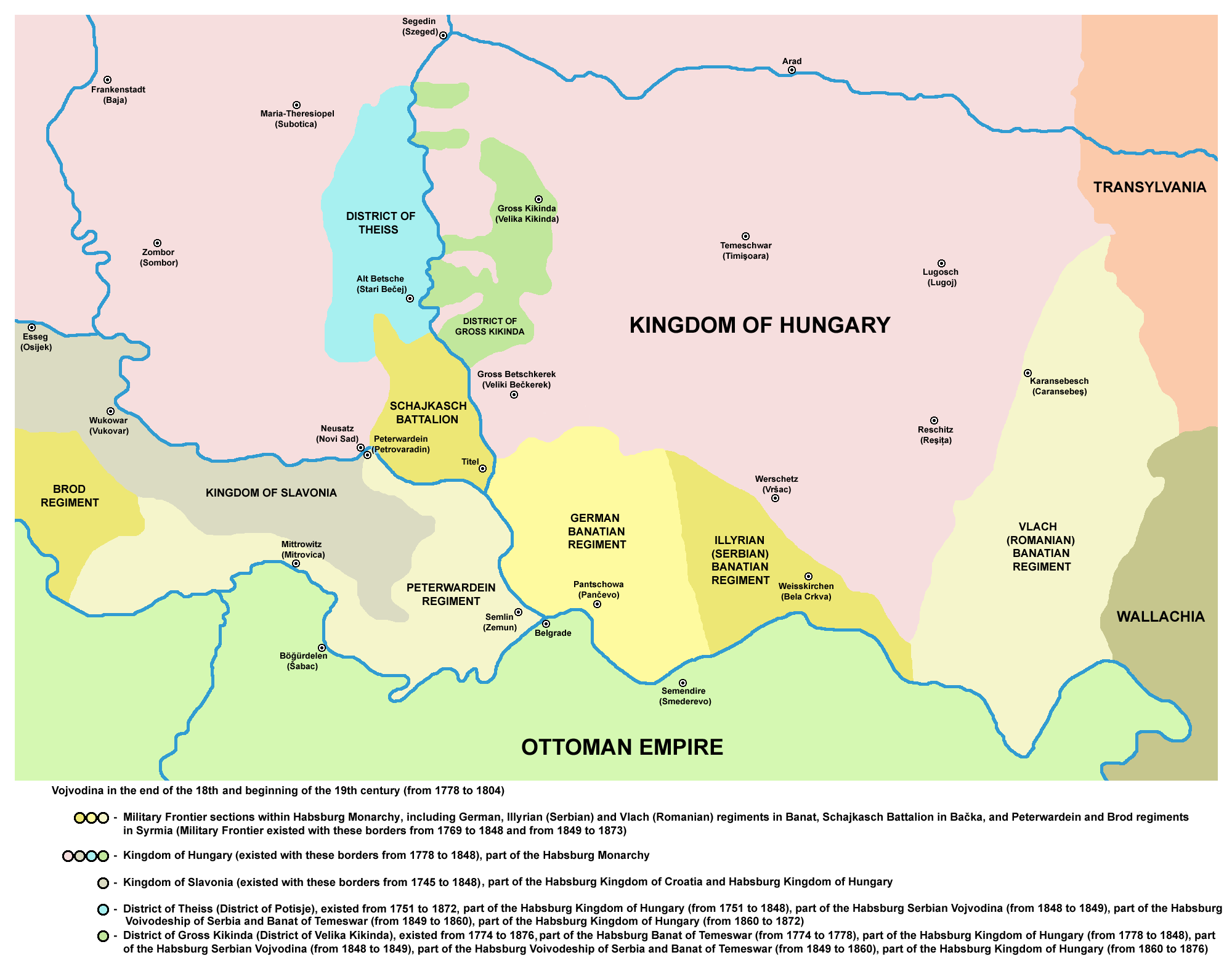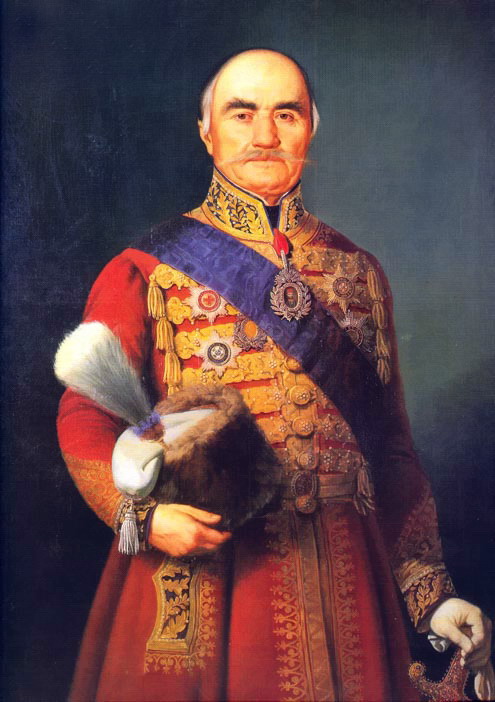|
Banat Krajina
The Banat Military Frontier or simply Banat Frontier (; ; ) was a district of the Habsburg monarchy's Military Frontier during the 18th and 19th centuries. It was located in southern parts of the Banat region. It was formed in 1764, out of territories of the Banat of Temeswar. Today, the territory is split between Serbia and Romania. Geography The Frontier was divided into Serbs, Serb (''Illyrian''), Germans, German (''Danube Swabian'') and Romanians, Romanian (''Vlach'') sections. It included parts of modern-day Banat (region), Banat and the south-eastern part of Bačka region, known as Šajkaška. Some of the important cities and places were: Pančevo, Bela Crkva (Vojvodina), Bela Crkva, Titel, Žabalj, Alibunar, Kovin, and Caransebeş. History The military province of Habsburg monarchy known as the Banat of Temeswar was created in 1718. In 1751, Maria Theresa of Austria, Maria Theresa introduced a civil administration for the northern part of the province. The southern part r ... [...More Info...] [...Related Items...] OR: [Wikipedia] [Google] [Baidu] |
Administrative Divisions
Administrative divisions (also administrative units, administrative regions, subnational entities, or constituent states, as well as many similar generic terms) are geographical areas into which a particular independent sovereign state is divided. Such a unit usually has an administrative authority with the power to take administrative or policy decisions for its area. Administrative divisions are often used as polygons in geospatial analysis. Description Usually, sovereign states have several levels of administrative division. Common names for the principal (largest) administrative divisions include: Federated state, states (subnational states, rather than sovereign states), provinces, States of Germany#States, lands, oblasts and Region#Administrative regions, regions. These in turn are often subdivided into smaller administrative units known by names such as comarcas, raions or districts, which are further subdivided into municipality, municipalities, Commune (administrativ ... [...More Info...] [...Related Items...] OR: [Wikipedia] [Google] [Baidu] |
Titel
Titel ( sr-Cyrl, Тител, ) is a town and municipality located in the South Bačka District of the province of Vojvodina, Serbia. The town of Titel has a population of 4,522, while the population of the municipality of Titel is 13,984 (2022 census). It is located in southeastern part of the geographical region of Bačka, known as Šajkaška. The town is famous for the fact that the Tisza river flows into the Danube there. Name In Serbian language, Serbian, the town is known as ''Titel'' (Тител), in Hungarian language, Hungarian as ''Titel'', in German language, German as ''Titel'' (and sometimes ''Theisshügel''), and in Latin language, Latin as ''Titulium''. History The Titelski Breg, Titel Plateau is an elevated region between the Danube and Tisza rivers, close to the confluence; about ; roughly . It has an ellipsoid form and is characterized by steep slopes at the margins. It has a substantial loess cover and is often called the Titel Loess Plateau; the loess on the p ... [...More Info...] [...Related Items...] OR: [Wikipedia] [Google] [Baidu] |
Bela Crkva, Banat
Bela Crkva ( sr-cyrl, Бела Црква, ; ; ; ) is a town and municipality located in the South Banat District of the autonomous province of Vojvodina, Serbia. The town has a population of 7,456, while the Bela Crkva municipality has 14,451 inhabitants (2022 census). Bela Crkva lakes at the outskirts of the town are a popular summer Tourism, tourist destination. Name The name of the town ''Bela Crkva'' means "white church" in English language, English. In Romanian language, Romanian, the town is known as ''Biserica Albă'' (formerly Albești), in German language, German as ''Weißkirchen'', in Hungarian language, Hungarian as ''Fehértemplom'' (formerly Fejéregyház), and in Turkish language, Turkish as ''Aktabya''. History Neolithic findings of ceramics and burial with Greek-style pots dating to late fifth century BCE have been found in the area. The town was founded in 1717 when this region was included into the Habsburg monarchy. It was part of the Banat Krajina, Banat ... [...More Info...] [...Related Items...] OR: [Wikipedia] [Google] [Baidu] |
Caransebeș
Caransebeș (; ; , Hungarian pronunciation: ) is a city in Caraș-Severin County, part of the Banat region in southwestern Romania. One village, Jupa (), is administered by the city. The city is located at the confluence of the Timiș River with the Sebeș River, the latter flowing from the Țarcu Mountains. To the west, it is in direct contact with the Banat Hills. It is an important railroad node, being located approximately 40 km from the county seat, Reșița, 21 km from Oțelu Roșu, 70 km from Hațeg, and about 25 km from the Muntele Mic ski resort, in the Țarcu Mountains. Climate Caransebeș has an oceanic climate (''Cfb'' in the Köppen climate classification), with an average of , but summers can be warm, with an average of . Rainfall can be quite abundant throughout the year. History The first traces of habitation here might date as far as Dacian times. Dacian ruins have been discovered recently near Obreja, a village 7 km away. As t ... [...More Info...] [...Related Items...] OR: [Wikipedia] [Google] [Baidu] |
Slavonian Military Frontier
The Slavonian Military Frontier ( or ; ; ; ) was a district of the Military Frontier, a territory in the Habsburg monarchy, first during the period of the Austrian Empire and then during the Austro-Hungarian Monarchy. It was formed out of territories the Habsburgs conquered from the Ottoman Empire and included southern parts of Slavonia and Syrmia; today the area it covered is mostly in eastern Croatia, with its easternmost parts in northern Serbia (mostly in Vojvodina region.) Divisions The Slavonian Military Frontier was divided between three regiments: Regiment N°VII, based at Vinkovci; Regiment N°VIII, based at Nova Gradiška and Regiment N°IX, based at Petrovaradin. Other important towns in the area included Sremski Karlovci, Stara Pazova, Zemun, and Sremska Mitrovica. History During the history, name Slavonian Military Frontier referred to different territories. It was first located in what is now Central Croatia and was known as the Varaždin generalat. It was ... [...More Info...] [...Related Items...] OR: [Wikipedia] [Google] [Baidu] |
Wallachia
Wallachia or Walachia (; ; : , : ) is a historical and geographical region of modern-day Romania. It is situated north of the Lower Danube and south of the Southern Carpathians. Wallachia was traditionally divided into two sections, Muntenia (Greater Wallachia) and Oltenia (Lesser Wallachia). Dobruja could sometimes be considered a third section due to its proximity and brief rule over it. Wallachia as a whole is sometimes referred to as Muntenia through identification with the larger of the two traditional sections. Wallachia was founded as a principality in the early 14th century by Basarab I after a rebellion against Charles I of Hungary, although the first mention of the territory of Wallachia west of the river Olt dates to a charter given to the voivode Seneslau in 1246 by Béla IV of Hungary. In 1417, Wallachia was forced to accept the suzerainty of the Ottoman Empire; this lasted until the 19th century. In 1859, Wallachia united with Moldavia to form the Un ... [...More Info...] [...Related Items...] OR: [Wikipedia] [Google] [Baidu] |
Transylvania
Transylvania ( or ; ; or ; Transylvanian Saxon dialect, Transylvanian Saxon: ''Siweberjen'') is a List of historical regions of Central Europe, historical and cultural region in Central Europe, encompassing central Romania. To the east and south its natural border are the Carpathian Mountains and to the west the Apuseni Mountains. Broader definitions of Transylvania also include the western and northwestern Romanian regions of Crișana and Maramureș, and occasionally Banat. Historical Transylvania also includes small parts of neighbouring Western Moldavia and even a small part of south-western neighbouring Bukovina to its north east (represented by Suceava County). Transylvania is known for the scenery of its Carpathian landscape and its rich history, coupled with its multi-cultural character. It also contains Romania's second-largest city, Cluj-Napoca, and other very well preserved medieval iconic cities and towns such as Brașov, Sibiu, Târgu Mureș, Bistrița, Alba Iuli ... [...More Info...] [...Related Items...] OR: [Wikipedia] [Google] [Baidu] |
Voivodeship Of Serbia And Banat Of Temeschwar
The Voivodeship of Serbia and Banat of Temeschwar, or Voivodeship of Serbia and Temes Banat (, , , ), was a crownland of the Austrian Empire that existed between 1849 and 1861, centered in Temeschwar. It was created by reorganization of administrative structures in regions of Serbian Vojvodina and Banat of Temeschwar. Its former area is now divided between Serbia, Romania and Hungary. In 1860-1861, it was reincorporated into the Kingdom of Hungary. The Voivodeship gave its name to the present Serbian Vojvodina. Names In contemporary German, the crown land was officially known as Patent vom 18. November 1849, RGBl. 25/1849: ('Voivodeship of Serbia and Temes Banat'; when definite). The forms Patent vom 24. Juni 1857, RGBl. 121/1857: ('the Serbian Voivodeship and the Temes Banat') and Gesetz 1. Februar 1854, RGBl. 28/1854: ('the Serbian Voivodeship ''with'' the Temes Banat'; the ''-e'' on is a now mostly obsolete dative ending) also appeared frequently in official documen ... [...More Info...] [...Related Items...] OR: [Wikipedia] [Google] [Baidu] |
Principality Of Serbia
The Principality of Serbia () was an autonomous, later sovereign state in the Balkans that came into existence as a result of the Serbian Revolution, which lasted between 1804 and 1817. Its creation was negotiated first through an unwritten agreement between Miloš Obrenović, leader of the Second Serbian Uprising, and Ottoman official Marashli Pasha. It was followed by the series of legal documents published by the Sublime Porte in 1828, 1829 and finally, 1830—the Hatt-i Sharif. Its ''de facto'' independence ensued in 1867, following the evacuation of the remaining Ottoman troops from the Belgrade Fortress and the country; its independence was recognized internationally in 1878 by the Treaty of Berlin. In 1882 the country was elevated to the status of kingdom. Background and establishment The Serbian revolutionary leaders—first Karađorđe and then Miloš Obrenović—succeeded in their goal of liberating Serbia from centuries-long Turkish rule. Turkish authoriti ... [...More Info...] [...Related Items...] OR: [Wikipedia] [Google] [Baidu] |
Maria Theresa Of Austria
Maria Theresa (Maria Theresia Walburga Amalia Christina; 13 May 1717 – 29 November 1780) was the ruler of the Habsburg monarchy from 1740 until her death in 1780, and the only woman to hold the position in her own right. She was the sovereign of Austria, Hungary, Croatia, Bohemia, Transylvania, Slavonia, Mantua, Milan, Moravia, Galicia and Lodomeria, Dalmatia, Austrian Netherlands, Carinthia, Carniola, Gorizia and Gradisca, Austrian Silesia, Tyrol, Styria and Parma. By marriage, she was Duchess of Lorraine, Grand Duchess of Tuscany, and Holy Roman Empress. Through her aunt, Charlotte Christine Sophie, she was cousins with Peter II of Russia, and through her other aunt Antoinette, Duchess of Brunswick-Wolfenbüttel, she was cousins with Elisabeth Christine, Queen of Prussia, the wife of Frederick the Great, and was also cousins with Duke Anthony Ulrich of Brunswick, the husband of Ivan VI’s regent, Sophie, Duchess of Saxe-Coburg-Saafeld and Queen Juliana Ma ... [...More Info...] [...Related Items...] OR: [Wikipedia] [Google] [Baidu] |









